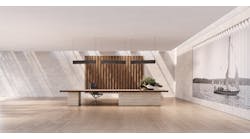The cubicle may be the comeback kid of the upcoming era of office redesign; however, what designers and planners don’t know is: will it come back with a touch a modern? As sleek and aesthetically pleasing open office spaces have grown in popularity with the millennial generation, so too have challenges. Between noise pollution, distractions and the lack of personal space, employees have found themselves caught between a sandalwood finished communal table, and a hard place. Here’s how architects are rising to the challenge of keeping the feel of the modern open office, while also dealing with the negative side effects of noise.
Creating Spaces for Quiet Work
“An open office design is counter-intuitive if everyone has their headphones in, because it’s too noisy,” says Yuritza Rodriguez of Gio Tan Design Associates Inc. In a world filled with options, it’s important to give your employees choice of how and where they can work.
“Open office design needs to include quiet zones that are great for private phone calls, small meetings and deep focus work,” says Rodriguez. Unassigned, enclosed rooms are great options for those who need to make a quick phone call, or simply need to get away from the office chatter.
Alternatively, furniture can be used to section off certain areas of the office to create individual, or small group work spaces. Featured here is the River™ by Global Furniture Group at The Hive Offices. Its high back helps reduce nearby noise and create the feeling of a private, secluded working space.
Installing Noise-Absorbing Panels and Surfaces
Noise-reducing panels and surfaces are great for reducing office sound without making big changes to the layout of a space. Hanging panels and other sound-absorbing surfaces can go a long way in reducing how far sound travels. At Airbnb’s San Francisco office, panels made with recycled denim or newspapers suspended from the ceiling is one way to reduce office noise. Other sound absorption techniques include panels, movable space dividers, ottomans and wallpaper.
Alternatively, furniture can be used to section off certain areas of the office to create individual, or small group work spaces. Featured here is the River™ by Global Furniture Group at The Hive Offices. Its high back helps reduce nearby noise and create the feeling of a private, secluded working space.
The Power of Plants
Plants are effective in reducing noise in the workplace; they are proven to absorb noise via their stems, leaves, branches and wooden trunks. This may be why you’re likely to find many open office spaces decked out in various, exotic foliage. This Nordea office, as shown below, is one example of an office that relies heavily on the use of plants; with strategic placement of plants next to employee workstations as a key sound barrier.
Low-Level Cubicles
Low-level cubicles serve as a middle ground between the open office and closed office design. Cubicles and wall partitions are tried and true methods to help with both noise reduction and offering employees privacy. Low-level cubicles help to achieve this, yet don’t completely close someone off from the rest of their team. As a bonus, many low-level cubicles and wall partitions now come in a variety of trendy design options.
Striking the right balance between employing an open plan with the ethos of an anti-open office is difficult, but necessary. Maintaining an open office space is great for bolstering collaboration, team-building and company morale. However, ensuring that employees have options for where and how they work within the office is equally important to ensure productivity and mental well-being. With good design and a little bit of strategy, this can be done, with positive results in both design and functionality.


